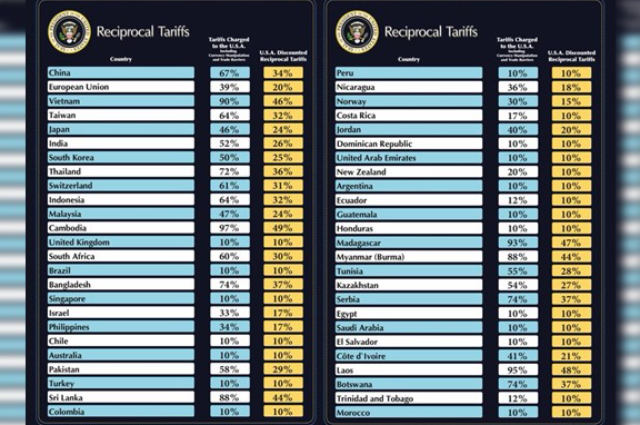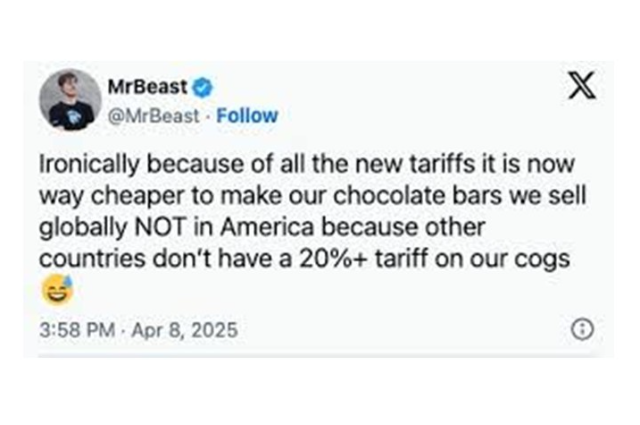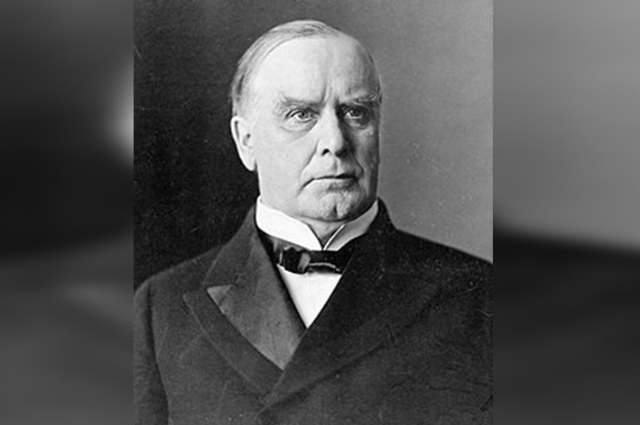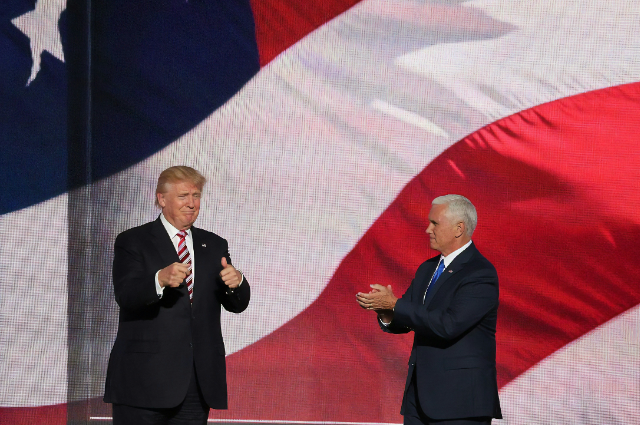
Photo by History in HD on Unsplash
The United States is now deeply involved in a global trade war which was marked by a series of tariffs. Even though President Donald Trump announced a 90-day pause on certain country-specific tariffs on April 2, many others remain in effect. A uniform 10% tariff still applies to all imports, while higher tariffs of 25% have continued on products like automobiles, steel, and aluminium. These aggressive trade policies have triggered similar reactions from other countries, especially China that was leading to a near-total breakdown in China-US trade relations.
Uncertain Markets and Fears of a Recession
This instability has had a major impact on financial markets worldwide. Despite the temporary tariff pause, stock markets are fluctuating sharply. Investors and companies are growing more nervous about the possibility of a global economic slowdown. Businesses are now forced to deal with more expensive supply chains, falling profit margins and perhaps the most damaging is a lack of clarity about what lies ahead.
Bond Markets Signal Deeper Trouble
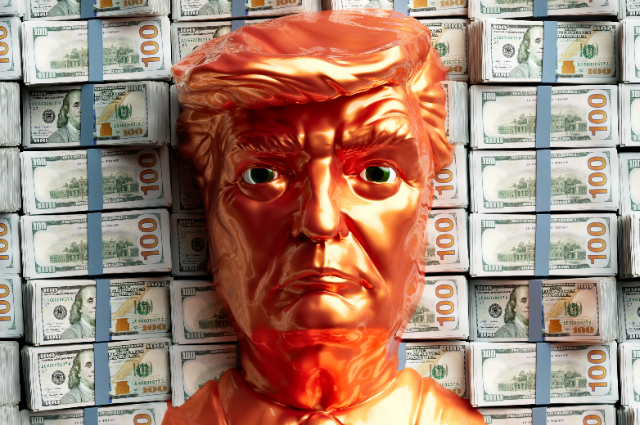
Photo by Igor Omilaev on Unsplash
In the United States, the bond market is also showing signs of stress. Yields on long-term bonds are starting to rise. Normally, when stock markets are risky, investors buy more bonds. This pushes bond prices up and yields down. But now, both stock returns and bond yields are falling at the same time which suggests that foreign investors might be pulling their money out of the US entirely. This kind of movement in the bond market is often a warning sign of a financial crisis. This concern may have pushed President Trump to temporarily hold off on further tariffs.
Policymakers around the World Struggle to Respond
Governments everywhere are trying to figure out how to handle the fallout. Responses have varied. Some countries, like China and Canada, have hit back with their own tariffs. Others are trying to negotiate trade agreements with the US. But reaching a deal isn’t simple — it requires knowing exactly what the US wants.
From the way the tariffs are being calculated, it seems the US is aiming for "balanced trade" — meaning it wants every country to export and import roughly the same amount when trading with the US. This is why Trump quickly dismissed the European Union’s suggestion that both sides should eliminate all tariffs. While that may sound fair, the US turned it down because it wouldn’t guarantee a balance in trade.
Why Balanced Trade is Not a Usual Goal
The idea of focusing on balanced trade is unusual. Trade deficits — when a country imports more than it exports — often happen because of differences in national savings and investment. For example, if a country discovers new investment opportunities but doesn't have enough savings, it may borrow money or sell equity to foreigners to fill the gap. This creates a trade deficit.
Likewise, when interest rates are low for a long time or when governments spend heavily and run large deficits, national savings tend to fall. This too, results in trade deficits. So, most countries don’t aim for perfectly balanced trade. Instead, they understand that importing more goods than they export means they must pay for the difference — either by selling their goods and services or by selling some of their assets to foreign buyers.
From this perspective, when the US runs a trade deficit, it is essentially allowing other countries to buy US assets in exchange for goods. This isn’t very different from how businesses and households operate. A company that wants to build a new factory might borrow money if its profits aren’t enough — that’s similar to a trade deficit. A family that borrows to pay for a wedding is also running a small-scale version of the same thing. By imposing tariffs, the US is, in a way, showing dissatisfaction that foreign countries are willing to accept US assets in exchange for goods.
What This Means for India: Risks and Opportunities
This confused global environment presents both problems and possibilities for India. As the threat of a global recession grows, countries around the world will likely reduce their spending, which could hurt demand for Indian exports. Additionally, India may face stiff competition from extremely low-priced Chinese goods as China tries to find new buyers after losing access to the US market.
A Silver Lining: Lower Import Costs and New Investments
But there are some upsides. As global prices drop, India might be able to import goods and raw materials at lower prices. This can help control inflation and create room for the Reserve Bank of India to cut interest rates to support economic growth.
Furthermore, some multinational companies — like Apple — are looking to shift their manufacturing operations out of China. India with its large pool of semi-skilled workers is in a strong position to attract some of this investment.
A Strategic Trade Deal with the US is Crucial
India’s top priority should be negotiating a trade deal with the United States. But there’s a catch. Simply lowering tariffs might not satisfy the US — it wants a balanced trade relationship. This could make negotiations more difficult.
Still, India must work to protect its service exports, which are a major source of income, especially from the US. So far, US tariffs have only targeted goods, but this could change. A possible solution might be for India to agree to buy more American goods — by replacing some imports from other countries — in exchange for protection of its service exports. While this may be a tough compromise, it could be necessary.
Agricultural Reform: An Opportunity in Disguise
The US also wants more access to Indian agricultural markets. This could actually help India push forward with much-needed farm reforms. Trade talks can serve as a political opportunity to make bold changes in this sector.
At the same time, India should not rely solely on the US. It should accelerate trade negotiations with other major groups like the European Union, ASEAN, CPTPP, and MERCOSUR, and explore new bilateral or multilateral trade agreements.
Trump’s Big Announcement: A Shockwave on April 2nd
On 2nd April 2025, Donald Trump announced his presidential tariffs. He imposed tariffs on more than 90 countries and in his typical, dramatic way, he said, No more. "Many countries have ripped us off left and right." In his opinion, the rest of the world has been looting America for a long time. America, the richest country in the world was being ripped off by the rest of the world.
"But now, it's our turn, to do the ripping." Once he announced this, share markets all over the world crashed. Within a week, trillions of dollars were lost and the world is in danger of a global recession. "The world matches on the edge of a potential global recession." Monday, 7th April, was the worst day for the stock market. Whether in Hong Kong or Taiwan, China or Japan, Germany or the UK, the US or India, the stock market fell drastically everywhere. The strange and childish way that things have been handled here can be seen in this example.
On 2nd April, the US President Donald Trump imposed a 34% tariff on China. 2 days later, in response to this, China imposed 34% tariffs on America. Trump did not like this, so he told China to withdraw their newly imposed tariffs. If they don't, he said that he will impose another 50%. "If the tariff isn't removed by tomorrow at 12 o'clock, we're putting a 50% tariff on above the tariffs that we've put on." But China is inflexible in its stance and then on 9th April, America imposes a further 50% tariff on China.
In response to this, China imposes another 50% tariff on America and so, these two countries are engaged in a game of tit-for-tat situation. This trade war is hidden from no one. To understand these geopolitics combined with the tariffs system one needs to first understand the background.
What is a tariff?
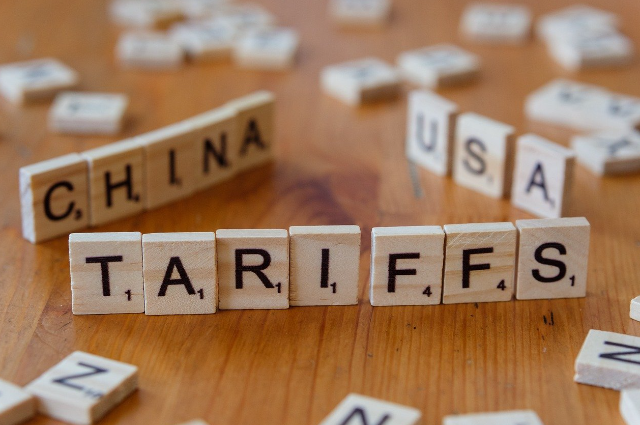
Image by Markus Winkler from Pixabay
A tariff is a type of tax. This tax is imposed on goods imported from abroad. For example, if you buy a smartphone made outside India, like an iPhone in India then a 15% import tax is imposed on it by the Indian government.
Import tax is a type of tariff. Things like clothes attract a 20-25% import duty. Import duty is also a type of tariff. There are mainly two reasons behind imposing tariffs. First, to boost the government's revenue. Like the other taxes, this is a source of government income. The second reason is to protect local industries. Since, by imposing tariffs, goods imported from foreign countries become expensive and domestically produced goods remain comparatively cheaper. So, people are incentivised to buy more of the domestic products.
That's how local industries get an advantage. Many countries impose tariffs because of this. There's nothing wrong with this. In fact, if tariffs are imposed smartly, then it helps the country's economy. For example, take the South Korea Case Study as an example. There, during the 1980s and 1990s, the farmers were facing a lot of difficulties. The farmers didn't have access to modern technology. So, the prices at which they could sell their rice in their country were much higher than the cost of imported rice from America, Thailand, and Vietnam.
Why Is Trump Using Tariffs? A Closer Look at His Trade Strategy
Trump’s Belief in ‘America First’ Trade
Former President Donald Trump has repeatedly defended his use of tariffs as a tool to strengthen the American economy. He believes that by making foreign goods more expensive, American consumers will be more likely to buy products made in the United States. This, he argues, will boost local manufacturing, increase tax revenue from imports, and attract more investment into American industries.
Trump also wants to narrow the trade deficit—the difference between how much the U.S. buys from other countries compared to what it sells. He has claimed that the U.S. has been taken advantage of for too long by what he calls "cheaters" in the global trade system.
Tariffs Tied to Border and Security Issues
Trump's tariffs were not just about trade; they were also linked to political and security concerns. Early in his presidency, he placed tariffs on imports from China, Mexico, and Canada. He said these countries needed to do more to stop the flow of illegal drugs and undocumented migrants into the U.S.
Despite his firm stance, Trump faced criticism from both domestic and international leaders. Even some members of his own Republican Party joined Democrats and foreign officials in speaking out against the negative consequences of his tariff policy.
Economic Impact According to the IMF
The International Monetary Fund (IMF) has voiced concerns about Trump's tariffs. In its latest global economic forecast, the IMF lowered its expectations for worldwide growth in 2025 from 3.3% to 2.8%. For the U.S. alone, it cut the expected growth rate from 2.7% to just 1.8%. The IMF also warned that the risk of a U.S. recession in 2025 has increased because of these trade measures.
The China Conflict: A Deeper Dive Into the US-China Trade War
In 2024, the U.S. had a large trade deficit with China—it imported $440 billion worth of goods from China but exported only $145 billion to Beijing. Trump began placing major tariffs on Chinese products during his first term, and these were not only kept in place by President Joe Biden but even expanded. This effort reduced China’s share of total U.S. imports from 21% in 2016 to 13% by 2024. But China continues to be a key supplier, shipping everything from electronics like iPhones to toys and clothes.
Tariff Evasion and Loopholes
Despite the high tariffs—some as steep as 145%—analysts have noted that many Chinese goods still reach the U.S. indirectly through countries in Southeast Asia. This strategy may help some exporters avoid the full cost of the tariffs.
Possible Signs of a Trade War De-escalation
There are some signs that the tension might ease. U.S. Treasury Secretary Scott Bessent recently described the current trade conflict as "unsustainable" and said he expects a reduction in hostilities. Trump also commented on 22nd April that he would approach future talks with China with a more flexible attitude by suggesting that some tariffs could be lowered if a fair deal is reached—though not completely removed.
The Ripple Effect on American Consumers: Higher Prices on Everyday Goods
One major concern is how tariffs could affect prices for American consumers. When companies have to pay more to bring goods into the U.S., they often pass those costs on to buyers. This could mean higher prices for things like clothes, coffee, alcohol, and electronics.
Even products made in the U.S. might become more expensive if they rely on foreign-made parts. For example, many cars are built using parts that travel between the U.S., Mexico, and Canada multiple times during production. Analysts from the Anderson Economic Group estimate that tariffs could add $4,000 to $10,000 to the cost of some vehicles.
Logistical Delays and Red Tape
The new tariffs have also led to stricter inspections at U.S. borders, slowing down the shipping process. DHL, a major delivery company, said it stopped sending packages worth more than $800 to U.S. customers because of the increased tariffs. Hongkong Post also announced it would stop shipping parcels to America starting 27 April.
How Other Countries Are Reacting to Trump's Tariff Pause and The 90-Day Pause: A Window for Negotiation
Trump has temporarily paused some of the higher tariffs, setting a new baseline rate of 10% for certain goods. This 90-day window is being seen as a chance for countries to negotiate better trade deals with the U.S.
The European Union is actively seeking an agreement and has warned it may take retaliatory steps if talks fail. EU President Ursula von der Leyen confirmed that the bloc is preparing countermeasures.
Calls for Unity and Strategy
Leaders in Europe and Asia have urged cooperation during the tariff pause. Poland's Prime Minister, Donald Tusk, said all sides should use this opportunity wisely, emphasizing that strong U.S.-European ties are vital. Germany’s incoming Chancellor Friedrich Merz added that the pause proves Europe’s united trade strategy can work. Vietnam also hopes to turn this pause into a more formal trade deal with the U.S., including agreements on tariffs.
Canada Responds with its Tariffs
Canada, which faced tariffs higher than 10%, responded by placing a 25% tariff on certain American-made vehicles on 9 April. This shows that other countries are not only negotiating but also taking steps to protect their own economies.
A Smart Tariff Story: South Korea’s Rice Revolution and How Strategic Tariffs Saved Farmers from Poverty?
In order to protect the livelihoods of South Korean farmers, South Korea had imposed tariffs strategically. They imposed a limit, upto which rice could be imported into their country without any tariffs. But if the import of rice exceeded that limit, it'd be subjected to high tariffs. As high as 500% or more. Consequently, the imported rice became more expensive and South Korean farmers could get the opportunity to remain competitive. Gradually, they began using modern technology, with the government spending on rural infrastructure and education.
A few decades later, when the efficiency of these farmers was at a global level then they gradually removed the tariffs. Now think about it, had there not been any tariffs here, how would it have impacted these farmers? The local farming sector would have been destroyed and there would've been large-scale poverty and unemployment. This proves that tariffs aren't a negative step in and of itself. So the question here is, how are the tariffs imposed? On which things? and on which countries? Because think about things from a different perspective.
Diplomacy vs. Dictation: The Right Way to Impose Tariffs and Why Negotiation Matters in Global Trade?
From the perspective of the country which exports its goods to another country. Suppose that India exports a lot of medicines to South Korea. So much so that South Korea has become the largest consumer of Indian medicines. One day, suddenly, South Korea imposed a 100% tariff on the medicines imported from India. South Korea wants to promote its domestic medicine industries. How would India feel in this situation? India won't be happy with this. Especially if South Korea is the biggest consumer of Indian medicines.
Because India's domestic industry would be destroyed if their medicines stopped selling in South Korea. This is why when a country imposes tariffs to protect its local industry, it can be damaging to other countries. There are many cases where the exporting country doesn't like it so it retaliates and imposes tariffs on the first country. This is how a tariff war starts. It can also be called a trade war. A simple way to avoid this is to negotiate with the other country. Talk to the other country to explain the problem which makes it necessary for you to impose higher tariffs. If the other country sympathises with the situation then the two countries might be able to come up with a mutually beneficial agreement. You might agree to have tariffs imposed on your exports, but you can negotiate a limit so that you can still sell a large chunk of your products in their country. Friendly negotiations that is crucial. Now, in case of US President Donald Trump, he actually did not even consult anyone and imposed tariffs on 90 countries out of nowhere.
That too with such an attitude. Practically said that he'd do whatever he wanted to.
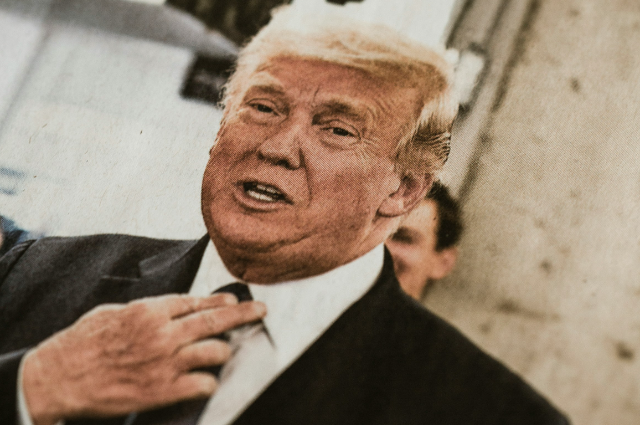
Photo by Markus Spiske on Unsplash
These were his words - "We're gonna have to go through a little tough time, maybe." "They all understand." "They're ripping us off and they understand it."
Obviously, many countries weren't happy about this and they started imposing retaliatory tariffs. On his part, Donald Trump said that he imposed tariffs to reduce America's trade deficit. That's why, on the day he imposed tariffs, he named it as the Liberation Day.
Now, if you want to ask what is a trade deficit, let's take the example of two countries. One is America and the other is China. Assume that the total goods exported by America to China is worth $1 billion. The total goods exported by China to America is worth $2 billion. So here, expenses minus revenue, America's trade deficit is at $1 billion. [$2 billion minus $1 billion] The difference between export and import. Now, being in a trade deficit isn't inherently wrong. Roughly speaking, it is said that a trade deficit is bad because your country depends a lot on another country.
But if your country's economy is strong, and your country receives a large amount of foreign investments, and you don't depend on another country for something critical in such cases, being in a trade deficit won't be bad. But Trump thinks that America's trade deficit is detrimental. To get out of this trade deficit, he claims to have imposed these tariffs. To impose these tariffs, he went as far as to use the emergency powers. I am not kidding! He declared being in a trade deficit to be a national emergency.
Trump’s Tariff Math: A Grade-School Error with Global Consequences
"A very national emergency that threatens our security, and our very way of life."
Experts say that misusing the Emergency Act like this isn't right in a democracy. But come, let's take a closer look at the tariffs imposed by Trump. Donald Trump stood there with a big board that had the tariffs for different countries. Every foreign good imported into America got atleast a 10% tariff. This 10% tariff has also been imposed on those countries with whom America isn't even in a trade deficit. Trump even used the excuse that because some countries impose tariffs on goods exported by America, the tariffs imposed by Trump should actually be considered reciprocal tariffs.
"Reciprocal, that means they do it to us, and we do it to them." 49% on Cambodia. 46% on Vietnam. A 20% tariff on the European Union. 32% in Taiwan. 25% on South Korea, 26% on India, and 17% on Israel. After the tit-for-tat game with China, the final tariffs on China have reached 125%. On the other hand, China retaliated with 125% tariff on America.
The Flawed Formula Behind the New Tariff Rates
It's interesting to see how these exact numbers were calculated. A simple formula was used here. They took the trade deficit of any country with America and divided it by the imports coming from that country, and half of the resulting percentage became the new tariff to be imposed on that country by Trump.
For example, America has a trade deficit of $295 billion with China and the American goods imported by China are worth $439.9 billion. According to the formula, the percentage here is 67%.
The trade deficit between the two countries is 67%. But here, Trump said something senseless. Trump said that this 67% is the rate of tariff which China imposes on American goods. Not true at all. He claimed this was the Chinese tariff, and imposed a tariff of half of it at 34%. They did this to every country. I don't understand how no one around Trump noticed this. This formula can be understood by primary school kids too.
Penguins Pay Too: The Antarctica Absurdity and will even Uninhabited Islands Face Trade Taxes?

Photo by Tam Minton on Unsplash
Trump crossed all the limits of foolishness when he imposed tariffs on some uninhabited islands near Antarctica. Heard Island and McDonald Island are some islands near Antarctica. No humans live there. No human has even gone there in the last 10 years, There are only penguins on that island. But now Trump imposed a 10% tariff on these islands as well. Let's check out how the penguins reacted to Trump's announcement. No, seriously, these islands are so isolated that you'd need to take a 2-week-long boat journey from Australia, and no human has undertaken this journey in the last 10 years. Could it be that when Trump saw that this island was called McDonald Island, he considered it to be some sort of McDonald's Disneyland. Anyway, jokes and satire aside, these tariffs have a real impact. America is a huge consumer market. Small and big businesses all over the world depend on selling their products to American consumers. That's why many countries imposed retaliatory tariffs to fight against America.
Trump's Trade Tariffs Reach the Ends of the Earth: Even Antarctica-Adjacent Islands Not Secure
In a surprising move that reflects just how far-reaching U.S. trade policies have become, a group of remote, icy islands near Antarctica—Heard Island and McDonald Islands—have been included in former President Donald Trump’s global trade tariff plan. Despite having no residents and being covered in glaciers, these islands were hit with a 10% tariff on goods exported to the U.S.
These islands are part of Australia’s external territories and are among the most isolated places in the world. They lie deep in the Southern Ocean and can only be reached by enduring a two-week boat journey from Perth, on Australia’s western coast. With no permanent population and no recorded human presence for nearly a decade, their inclusion in the trade measures has raised many eyebrows.
Confusing Inclusion on the Tariff List
The White House released a list of “countries” and territories that would be affected by the new tariffs—and surprisingly, Heard and McDonald Islands made the cut. This decision is puzzling to many, given that the islands have no real economy, no infrastructure, and no known exports.
Adding to the confusion, George Plant, an Australian administrator for Norfolk Island (another external territory), challenged the data being used to justify these tariffs. He stated that there are no known exports from Norfolk Island to the U.S., nor are there any trade barriers affecting goods entering the island.
Australian Prime Minister Responds: ‘Nowhere on Earth Is Safe’
Australian Prime Minister Anthony Albanese commented on the unusual situation by pointing out the overreach of the policy. Speaking with a mix of sarcasm and concern, he said, “Norfolk Island has got a 29% tariff. I’m not quite sure that Norfolk Island… is a trade competitor with the giant economy of the United States, but that just shows and exemplifies the fact that nowhere on Earth is safe from this.”
Albanese’s remarks reflect a broader concern that even the most peaceful and remote parts of the world are not immune to the fallout of international trade disputes.
What Are External Territories and Why Are They Targeted?
Heard Island and McDonald Islands are considered external territories of Australia. These regions are officially part of the country but are not self-governing. Although they fall under Australian federal jurisdiction, they are often treated separately for administrative and statistical purposes.
Other Australian external territories—such as Christmas Island, the Cocos (Keeling) Islands, and Norfolk Island—also appeared individually on the tariff list. This led to different tariff rates being applied even though all these places are technically part of Australia.
For example, while the mainland faced a 10% tariff, Norfolk Island was hit with a staggering 29% rate. This is particularly surprising given its small population of just over 2,100 people and limited trade activity.
The Mystery of the Export Numbers
According to trade data, Norfolk Island exported goods worth about US$655,000 (around A$1.04 million) to the U.S. in 2023. The majority of these exports—over US$413,000 ($658,000)—were leather shoes. While small in scale, these numbers at least make some sense.
However, things become more mysterious when we look at Heard Island and McDonald Islands. These islands are completely uninhabited and have no buildings. They do support a fishery in surrounding waters, but no permanent operations or facilities exist on land.
Despite this, the World Bank reported that in 2022 the U.S. imported US$1.4 million worth of goods from these islands. Strangely, almost all of these imports were listed as “machinery and electrical” items. No one seems to know what those items were or how they were exported from a place with no people or infrastructure.
Even more curiously, in previous years—between 2017 and 2021—U.S. imports from these islands ranged from just US$15,000 to US$325,000. The sudden jump in 2022 has only added to the confusion.
Calls for Clarification
The White House, Australia’s Department of Foreign Affairs and Trade, and the Australian Antarctic Division were all contacted for clarification, but no explanation has been provided yet. The bizarre case of uninhabited islands getting hit with trade tariffs raises questions not just about the data used in trade policy, but about how global economic decisions are being made.
A Trade Policy That Reaches Too Far?
Trump’s sweeping tariffs, initially intended to protect American industry and push back against trade imbalances, are now impacting regions that have little or no involvement in trade at all. The inclusion of Heard Island and McDonald Islands—remote, frozen, and uninhabited—highlights the strange and sometimes confusing reach of modern trade wars. As countries scramble to understand the logic behind such policies, one thing is clear: no matter how small or remote, no place seems to be completely off the radar in the current climate of international trade tensions.
China, the European Union, and Canada deliberately targeted those places in retaliation for where Trump gets the most votes in America. China targeted corn farmers and car makers. Canada imposed tariffs on poultry farms and AC manufacturers. Europe imposed tariffs on steel mills and slaughterhouses. These are the sectors that have the most number of people who support and vote for Trump. Their logic is simple. If they want to make a real impact, they need to affect those people who voted for this thoughtless politician.
Actually, imposing such tariffs on so many countries, all of a sudden, without talking to them, will definitely cause harm and both sides will suffer. The country from where you import goods and the businesses of that country would be affected. People will buy fewer goods. But in your own country, when foreign goods get expensive and not just a few things, but when almost everything gets more expensive, the brunt of it all will be borne by the common man's pockets. Trump's tariffs would affect Americans the worst.
How do Tariffs affect even everyday Goods and Entrepreneurs?
Today, we live in a globalised world. The goods sold in America, in most cases, they are either made abroad entirely, or their small components, raw materials or ingredients are imported from abroad. Take Mr Beast's example and the chocolates he sells. He tweeted that although it is made in America, but the cacao beans used in the chocolate are imported. Mostly from African countries. With the increase in tariffs, it'd be more expensive to import the raw materials, and it will make the chocolates more expensive. That's why he tweeted that after these tariffs, it would actually be cheaper to make these chocolates outside the US.
History Repeats: Lessons from Past Tariff Blunders and From McKinley to the Great Depression and Beyond
If we look at history, every time America has imposed tariffs like this without thinking it through, broadly speaking, in many aspects, and in many countries, America was the one to suffer the losses. In 1789 the first American President, George Washington brought the Tariff Act. As per this, there was a 5% tax on imported goods. But in 1890, tariffs were increased at a large scale.
More than 1,500 goods were taxed at 49.5%. William McKinley was responsible for these increased tariffs. Also known as Napoleon of Protectionism. Trump considers him a hero, and calls himself, "I'm a fan of William McKinley."
But do you know what happened because of these tariffs? In 1893, there was a depression in America. Unemployment reached 25%. After 1910, the Democrats came into power. They supported free trade. Once they lowered the tariffs there was rapid economic growth in America. But in 1920, the Republican Party came into power again.
To protect the farmers and industries, tariffs were raised once again. Then in 1930, Republican President Herbert Hoover brought the Smoot-Hawley Tariff Act. Under this, in about every sector, the tariffs were increased by 20% or more. What happened after this? The other countries weren't happy with this. Those countries retaliated. Imposed retaliatory tariffs. After that, international trade declined worldwide. Between 1929 and 1934, global trade decreased by 66%. In 1929, there was the Great Depression.
Though it was caused due to other reasons, the situation only worsened and for that, the blame lies with these tariffs. For about 10 years, the American and global economies remained stuck and it was only in 1939 once the Second World War began that factory production picked up in America, and America could finally come out of this depression. Since the Second World War, America has always encouraged free trade. It has always told other countries to keep their tariffs as low as possible.
The lower the tariffs, the more international trade there will be. Every country stands to benefit from this. Based on this philosophy, the WTO or the World Trade Organisation was formed. It became a platform for negotiation for the whole world. Even now, if you go to the WTO's Wikipedia page, you will see a Purpose section. Let's read that. "Reduction of tariffs and other barriers to trade." The WTO was formed with the aim to reduce tariffs all over the world.
In the establishment and promotion of this international organisation, America played a leading role. But now, after Donald Trump's presidency, everything has turned upside down. Other countries aren't sure how much they can trust America. What does America actually believe in? The Prime Minister of Singapore gave an interesting statement about this. "Trade war escalated to armed conflicts and eventually the Second World War." "The last time the world experienced something like this was in the 1930s. Trade wars escalated into armed conflicts, and eventually, the Second World War.”
No one can say how the current situation will unfold, in the coming months or years. We must be clear-eyed about the dangers that are building up in the world. Global institutions are getting weaker. International laws are eroding. More and more countries will act based on narrow self-interests and use force or pressure to get their way and this is the harsh reality of our world today. He states that the last time there was a trade war on such a large scale, it caused armed conflicts which eventually resulted in the Second World War.
A Sudden U-Turn: The 90-Day Pause, Confusion, Chaos, and Accusations of Market Manipulation
It's getting more and more difficult to predict what will happen next. The global economy is going through quite an unpredictable time and Donald Trump's behaviour is responsible for this unpredictability. On the night of 9th April, the news broke that Trump has paused tariffs on all countries for 90 days and has reduced them to only 10%. Except for China. Tariffs on China have been increased further.
Donald trump statement - "I did a 90-day pause for the people that didn't retaliate. That's what I did with China. Because they did retaliate."
The rates of tariffs fluctuate each day and people are confused. What is Trump trying to do? Friends, what do you think? Some people have made accusations of stock market manipulation too. When he suddenly imposed tariffs, the stock market fell. But the day the tariffs were removed, that morning before the tariffs were lifted, he tweeted this. "This is a great time to buy!!!"
He knew that as soon as the tariffs would be lifted, the stock market would go up again. Here this post was meant to tell his followers, to go and buy stocks. As soon as he announced the pause of the tariffs, the stock market suddenly shot up. This is a straightforward and clear proof of stock market manipulation. But the question arises, who will dare to investigate the American President? And even after investigating, the question is, is there a judge in America who will dare to pass a judgement against Donald Trump?
The Two Faces of Trump’s Tariff Play Blunder or 4D Chess: What Was the Endgame?
Another theory here is that Donald Trump took this huge U-turn because he hadn't expected the world to react this way towards his tariffs. If so, this shows his incompetency. If not, some allege that this was Trump's actual plan, that he was playing 4D chess by first imposing such high tariffs globally, and then taking them back but letting the ones on China remain. A plan to 'trap' China. This too shows Trump's shortsightedness. Imposing and removing tariffs like this on such a large scale is not a game.
This affects millions of small and big businesses all over the world. Millions of businesses who cannot price their goods properly, because they don't know what will be the tariffs in future and how these taxes affect their profits. Will they remain profitable or not? It's the same as trying to kill a cockroach in your home by setting fire to the house. The same logic behind demonetisation. But it's impact is ten times worse.
Conclusion
Trump’s use of tariffs is part of a broader plan to reshape U.S. trade policy, reduce foreign dependence, and revive American manufacturing. While the approach has some supporters, it has also led to criticism, economic uncertainty, and rising tensions with trade partners.
The coming months will reveal whether these high-stakes measures lead to better deals—or simply higher prices and strained international relations. The world is entering a period of major change in global trade, and the US is leading that change with its aggressive tariff policy. While this brings serious risks — including a possible global recession — it also opens doors for countries like India to adapt, grow, and seize new opportunities. Careful negotiation, strategic planning, and swift action will be key to turning this uncertain time into a path for future success.
. . .
References:
- https://www.theguardian.com/us-news/2025
- https://www.theguardian.com/us-news/2025
- https://www.theguardian.com/australia
- https://indianexpress.com/article/opinion
- https://www.ndtv.com/world-news
- https://www.bbc.com/news/articles/cn93e12rypgo
- https://apnews.com/article/recession-imf-economy
- https://www.livemint.com/market/stock-market
- https://indianexpress.com/article/business
- https://www.hindustantimes.com/world-news
- https://www.aljazeera.com/news
- https://www.independent.co.uk/voices
- https://www.ndtv.com/world-news
- https://indianexpress.com/article/world



